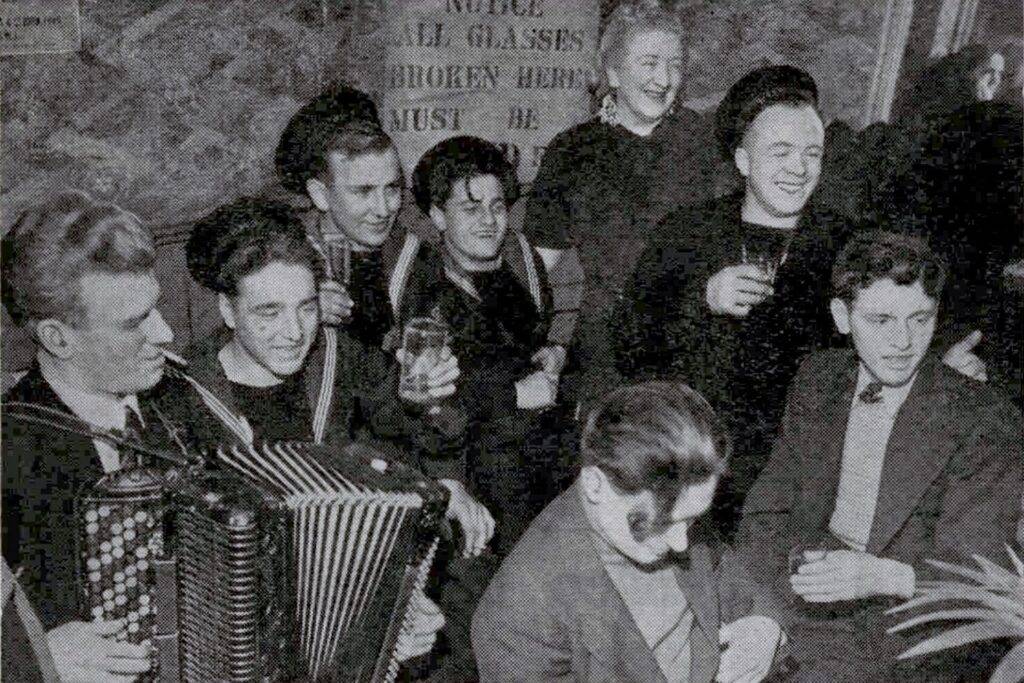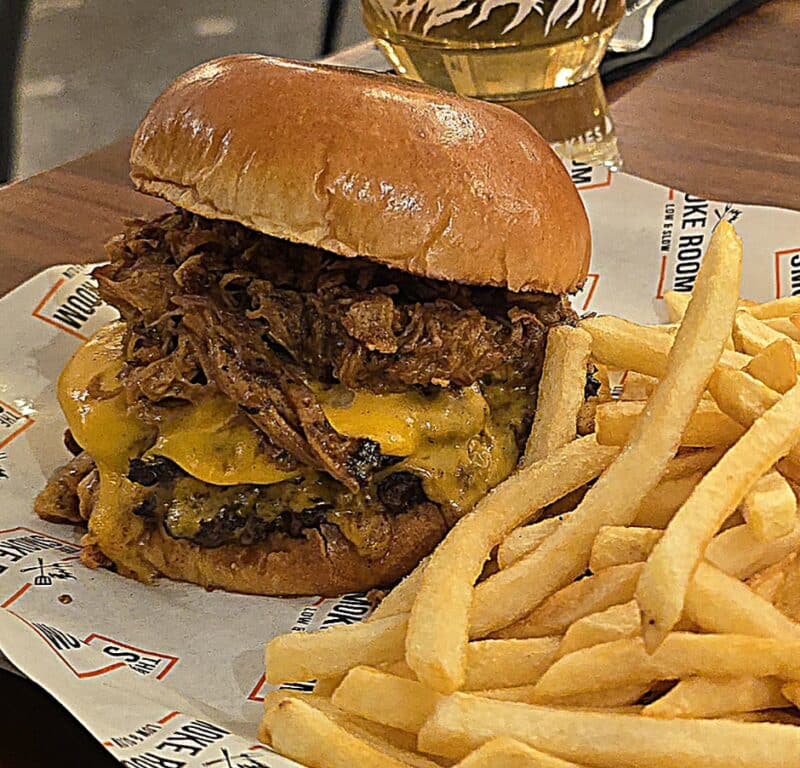“Some of Charlie Brown’s World Treasures”
An old, unused postcard discovered in an antiques shop in Exeter piqued my interest — a corner of Charlie Brown’s treasure-stuffed pub in Limehouse. If there were seven lost wonders of London, this would be one of them. I bought the postcard and decided to do some digging.
Charlie Brown’s, located on 114-116 West India Dock Road, was officially called the Railway Tavern, yet its landlord was such a celebrity, people only ever referred to the place as Charlie’s Brown’s (or occasionally Charlie’s Tavern). Brown, who served as the gaffer from 1893 till his death in 1932, sounds like a character; a retired boxer, who came to be known as ‘the uncrowned kind of Limehouse’. Said to be as gentle as a lamb and hard as nails, he “mixed with kings, with rogues, with bishops, with murderers, with diplomats,” wrote the Good Morning Journal, “And still he was Charlie Brown.” Said Wentworth Day in the Milwaukee Journal in 1929, when Brown was still alive and kicking:
Down in Limehouse, Charlie Brown is king, but that is merely by the way. You really begin to realise exactly what he means when you meet a man at the Gezeira club in Cairo or up river on a Perak rubber plantation. You mention Charlie Brown. “Oh! dear old Charlie!” explodes the stranger.
When Brown started out as landlord of the pub in 1893, Limehouse was in the heart of the bustling Docklands. It was also London’s original Chinatown. Although some of the saltier aspects of the area were embellished by the likes of Thomas Burke’s Limehouse Nights, it’s safe to say the place exuded character. “He made his tavern the outpost for unfortunates whom he guided and helped,” wrote one newspaper of Brown, “He lived to see Limehouse climb out of its dark age. He, in fact, played a major part in ridding it of its notoriety.”
‘Everyone’ drank at Charlie Brown’s, according to various reports; it was the original Cheers bar, with sailors and sundry characters from far-flung lands, in place of Frasier and Ted Danson.
Brown, who had sailed the seven seas in his younger days, acquired a penchant for exotic ephemera, collecting trinkets from all over the world. His seafaring punters added to the collection, which features on the postcard. Says Wentworth Day:
I will not attempt to guess the value of Mr Brown’s treasures, because he never sets a price on them himself and does not like to talk about their value; but it is enough to say that in that small room are five Ming vases 2,500 years old, an 800 year old Chinese ebony cabinet, a magnificent Louis XIV cabinet inlaid with enamel and Ivory, Waterford and Bristol glass, Chinese and Japanese ivories and more china, silver and pictures and bronzes.
Florentine cabinets, weapons from the Fijis, sharks’ teeth, a carved canoe and oil paintings worth thousands were also on show — which frankly beats a pool table and a TV showing Sky Sports, any day of the week.
Charlie Brown’s was a British Museum in miniature, albeit one where you could sink a few glasses of Charrington’s and maybe end the night with a punch up. Really, it was more of a house museum, like John Soane’s; said an article in The Bystander in 1928: “I have not seen, nor do I expect to see, so many beautiful objects in so small a space.”
You do wonder how sensible it was to have priceless artefacts in pub that must’ve had more than its share of rum characters; then again, surely no one would dare to filch anything — you’d have half of the East End after you. As for breakages? There must’ve been one or two, but I can’t find any accounts of that.
When Brown died in 1932, his funeral at Bow Cemetery attracted 16,000 mourners — proof that he’d made a few friends pulling pints over the years. After his death, things became a little confusing; Brown’s daughter, Ethel Chandler took on the pub with her husband. Meanwhile, Charlie Brown’s son — also called Charlie Brown — bought a pub called the Blue Posts directly opposite, arranging it with his half of inherited antiques. A bitter squabble ensued over which pub should rightfully be known as Charlie Brown’s. Eventually it was agreed both could be.
The original, curio-laden Charlie Brown’s pub — aka the Railway Tavern — closed in 1936, when Ethel Chandler sold up. The Belfast Telegraph suggests this loss as more devastating than Waterloo Bridge or the Adelphi. (Ironically, published on 1 December 1936, the article doesn’t mention the destruction of Crystal Palace the night before; it must’ve gone to print too soon.) “Did anyone not got there?” asks the mournful article, before recalling the film stars, royalty and “all kinds of queer characters” who supped among the objets d’art.
It continued as a pub, though, denuded of its antiques. An article from 1943 describes Charlie Brown’s as ‘maintaining a seafaring atmosphere’, with groups of Allied seamen standing under the flag of their nation (which was pinned to the ceiling), belting out their national anthem. By this time, the piano had made way for a radiogram, with ‘visitors singing modern dance numbers and girls jitterbugging.’ An accordionist, Jack Goodwin — who had been blinded in a torpedo incident — also played here. In a photo from one such blowout, a sign is visible saying that all broken glasses must be paid for… maybe it was the same rule for Ming vases back in Charlie Brown Snr’s day?
A later account of the pub in 1966 shows how it was at this point run by ex-stevedore Jimmy Vincent, who opened up at 6am — for a clientele of seafaring men, including “Tosh, a docker, Sparrow, who carries a monkey, Bent Neilsen, bo’sun of a Danish ship.” Still some characters, then.
To make things extra confusing, Charlie Brown Jnr had left the Blue Posts version of Charlie Brown’s, and opened a pub in South Woodford which was nicknamed… Charlie Brown’s. This happened after he’d been charged (and subsequently acquitted) with harbouring prostitutes — an accusation which Charlie Brown’s great grandson Peter, says was only brought about because Brown refused to give the local police back handers. Clearly, Charlie Brown Jnr had inherited his dad’s love for collecting things; a 1944 British Pathe video shows off the 16-strong watch collection he had on his person, plus 50-odd time pieces which were on display in his Woodford pub. Londonist reader Tim describes it thus: “It was the strangest pub I have ever been in… Pickled animals in jars behind the bar, including what looked like a dead cat and at least one embryo. Also a very large stuffed bear standing in the corner… It was rough as you like but they didn’t mind serving us underage drinkers.”
Although there were three Charlie Brown’s pubs in all, none survive today; the original Railway Tavern was bulldozed in 1989 to make way for the Limehouse Link tunnel, and Woodford’s Charlie Brown’s is remembered in the name of Charlie Brown’s Roundabout — the least the roundabout could do really, seeing as the pub was demolished to make way for it.
As for that magnificent collection of curios? Charlie Brown’s great grandson Peter claimed in 2020 that many had been sold off, although he’d inherited some.
It’s not quite the same, but there are a handful of cluttered boozers operating in London today which still look a little like the postcard I discovered. For a taste of Charlie Brown’s, try The Nag’s Head, The Heron, Gordon’s Wine Bar or the Churchill Arms.
Got any interesting insights into Charlie Brown’s pub? Feel free to drop an email to will@londonist.com








